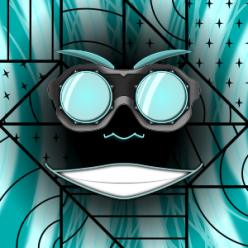written by Laurie Tom
Guilty Crown debuted as part of the fall 2011 anime season, but at the time it was up against Persona 4 for my viewing time, and being a Persona fan, that pretty much meant everything else, unfairly or not, was getting shut out.
But over the coming years, I’d occasionally see something that reminded me of it. I liked what I had seen of the character designs, there was that odd yet memorable title, and I liked the song “My Dearest” which plays over the first set of opening credits (which, by the way, gives a pretty accurate snapshot of who and what appears in the show).
Otherwise I didn’t know much about it except that somewhere I had read that the middle arc of the story reminded the viewer of the first Devil Survivor game, which I had enjoyed.
So when I found myself completely caught up on my simulcasts and still in the mood to watch more anime, I fired up Guilty Crown.
Guilty Crown is not an anime series that plays all its cards up front. For a near future science fiction series heavily centered around action, it brings up a lot of questions, and, I’m happy to say, answers nearly all of them.
The premise is that ten years ago, there was an outbreak in Japan of what became known as the Apocalypse Virus. It was so bad that foreign forces had to come in and take control of the country in order to keep the virus contained, and they’ve remained there ever since.
Shu Ouma, is the sort of nice-guy high school student protagonist that appears in many anime series, and in the first episode he is unfortunately the weakest element of the show. He accidentally gets tangled up in a resistance group called Funeral Parlor that is trying to overthrow the GHQ, the health organization that now rules Japan. Due to circumstances, he unintentionally absorbs an experimental fluid called the Void Genome that gives him “the power of kings” and allows him to pull objects out of other people that represent their hearts. These manifestations are called Voids.
Fortunately the first Void he pulls turns out to be a gigantic sword, which comes in handy in the action piece that closes out the first episode. Having him take out opposing mecha on foot is an amazing bit of shorthand to show just how powerful his new ability is, and if the story of Guilty Crown occasionally disappoints, the battles do not.
Shu initially tries to continue living a normal life after having gained the Void Genome, but circumstances conspire again and again to show him there’s really no going back; whether it’s the Funeral Parlor member who transfers to his school or a classmate who could sell him out after witnessing Shu fighting alongside the resistance.
In the early episodes Shu is largely pulled along by the will of other people and the shows works in its appreciably large cast, moving between the people in Funeral Parlor, the students at school, and the members of GHQ. After the bulk of the major players have been revealed, Shu starts to mature. The stakes rise and he begins to take ownership of his situation.
The first season in particular has light-hearted moments, such as Shu trying to figure out the identity of the student who was spying on him by pulling out the student’s Void. All he has to go on is the Void’s appearance, so he ends up running around campus randomly pulling things out of other kids (while profusely apologizing) to the entertainment of the viewer.
But the second season takes a much darker turn and nearly all of the levity is gone. At this point, it’s clear that there’s no such thing as normal.
The rest of the large cast varies in depth, though all are fairly distinctive. Aside from a couple of the senior GHQ members early on, I never had trouble telling anyone apart, though there isn’t the time in a 22-episode series for everyone to be drawn out as fully realized people. Still, with a large cast, there’s likely to be someone to root for even when the main characters aren’t pulling their best.
A few of my favorites:
Ayase is unusual in that she is a disabled character, a paraplegic in a wheelchair, but what is really remarkable is that she’s not the brainy hacker character. No, Ayase is Funeral Parlor’s kickass Endlave (mecha) pilot. Who cares if she’s in a wheelchair? She doesn’t need to walk to pilot a giant robot! I love that everyone in Funeral Parlor simply treats her as part of the team and no one comments on her disability until Shu joins the group and opens his mouth (and then she gives him a good tongue-lashing).
I have a tendency to like characters who do the wrong things for the right reasons, and Shu’s classmate Yahiro is that kind of character. His Void is a freakish pair of shears with the ability to sever life, but when we learn why his Void takes that form, the reason isn’t sadistic at all. Being a pragmatist, Yahiro is also the guy willing to make hard choices and present uncomfortable suggestions, and he does it without ever going off the deep end and becoming a monster like many of his counterparts in other anime series.
The last character I’ll mention is Daryl Yan, who is a part of the GHQ. He’s initially presented as a misanthropic villain who gets off on killing, but partway through the series the audience gets to see another side of him that makes him a more sympathetic character. Personally I wish Daryl had more chance to develop, because I liked where his arc was going, but I can understand why for plot reasons the writers ended up cutting that off. It just makes for a weird about-face near the end.
Unfortunately, with a large cast, that also means there are some characters that just never click. Inori, though the main heroine, is one of many emotionless girls popular in anime and her character arc is not anything that hasn’t been done before. I found I cared about her fate more because of Shu than because I cared about her.
Though Shu is clearly the main character with a tremendous special ability, Guilty Crown is pretty good at giving everyone a piece of the action. It never comes to a point where everyone sits back and lets Shu do his thing. The job is too big for a single person.
Overall, this series was a fun ride that only accelerated as it progressed. Though there were still a few “Huh?” moments that prevent the story from being completely coherent, they weren’t enough to ruin the ending. I’d recommend it.
Pluses: Nicely fleshed out world, excellent action set pieces, large cast makes it easy to find someone to like, large number of memorable vocal tracks
Minuses: Occasional bits of fanservice, plot sometimes take a backseat, some of the characters are archetypes we’ve seen before and don’t rise above their predecessors
Guilty Crown is currently streaming at Hulu and Funimation and is available both subtitled and dubbed. The subtitled version was watched for this review.
 Laurie Tom is a fantasy and science fiction writer based in southern California. Since she was a kid she has considered books, video games, and anime in roughly equal portions to be her primary source of entertainment. Laurie is a previous grand prize winner of Writers of the Future and since then her work has been published in Galaxy’s Edge, Penumbra, and Solaris Rising: The New Solaris Book of Science Fiction.
Laurie Tom is a fantasy and science fiction writer based in southern California. Since she was a kid she has considered books, video games, and anime in roughly equal portions to be her primary source of entertainment. Laurie is a previous grand prize winner of Writers of the Future and since then her work has been published in Galaxy’s Edge, Penumbra, and Solaris Rising: The New Solaris Book of Science Fiction.



